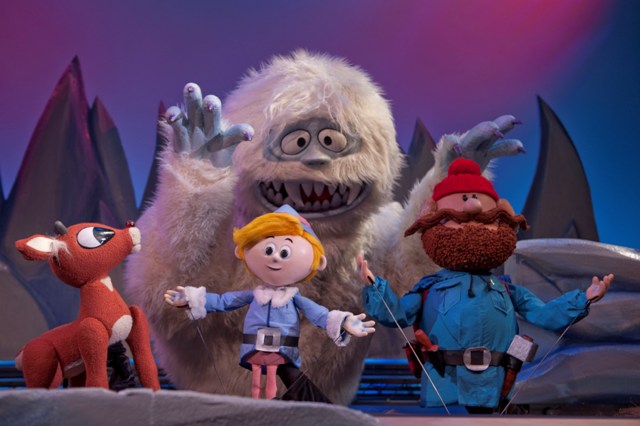
Bumble menaces Rudolph, Hermey and Yukon in The Center for Puppetry Arts' live production of RUDOLPH THE RED-NOSED REINDEER. Photo credit: Clay Walker.
“Could it be that you don’t know the story of Rudolph?” Sam the Snowman poses at the beginning of the Center for Puppetry Arts’ live stage production of Rankin-Bass’s stop-motion animated TV show about RUDOLPH THE RED-NOSED REINDEER, which runs through Dec. 31. It’s unlikely if you grew up in America any time within the past nearly half-century since the show, based on a popular 1949 song by Johnny Marks, premiered in 1964. In the ‘60s and ‘70s, the TV networks aired and re-aired a magical assortment of holiday specials for kids, and even when they cut back and many of these classics (including other Rankin-Bass treasures like SANTA CLAUS IS COMING TO TOWN and THE YEAR WITHOUT A SANTA CLAUS) became relegated to secondary cable, video and DVD, CBS continued to broadcast RUDOLPH (this year’s air-date is Dec. 4 at 8 p.m.). In fact, if you don’t get your tickets quickly, you may even miss the Center’s production. The Center for Puppetry Arts sold out its two-month run of RUDOLPH last year and deservedly so. Already almost all of this December’s performances are now sold out, and only limited tickets are available for the remaining November shows.
What’s behind the enduring appeal of a tale of a reindeer with a deformity that causes derision not just from his fellow deer (we all know children can be cruel) but surprisingly from Santa himself? At ATLRetro, it was always easy to understand. Rudolph, Hermey the elf who wanted to be a dentist, the misfit toys were us—the different kids, the geeks, the readers, the ones with glasses. And as we grew up, we found out, like Rudolph, we weren’t alone and that our differences were great reason to band together and declare ourselves “independent,” whether as science fiction fans or punk rockers or proud of being gay. As Clarice tells Rudolph, the fact that his nose is different from the rest is what makes it “special,” and it’s interesting and seems unlikely to be coincidental that RUDOLPH first aired in the heart of the Civil Rights Movement. Even the Bumble Snow Monster has a role to play; all he needed was a friend like Yukon Cornelius, willing to look beyond his monster-ness and listen. Well, after he removed his teeth—but who said that a 1964 TV special would or should be completely politically correct. I’d like to think that RUDOLPH taught me key lessons about tolerance, and hopefully it does for the kids, like me, who embraced it. I’m proud to say that I have watched it every Christmas season since I was two.
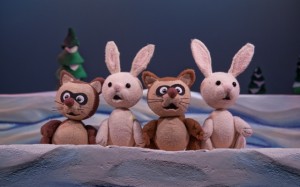
The raccoon and bunny pairs in the Center's RUDOLPH match perfectly with the CBS special. Photo Credit: Clay Walker.
Seeing it again at the start of this season reminds how true it is to the look and spirit of the TV show, which seems perfectly suited to puppetry. Even King Moonracer, the identical pairs of woodland creatures and the Christmas trees are perfectly crafted to match what we saw in our living rooms. The voices match unexpectedly well, too, including then-famous folk/ballad singer Burl Ives, who voiced the original Sam. Last year I was a little disappointed at the simplistic projected graphics intermingled with the show, but I’m over that now, and have to say that as a package, it’s nearly picture-perfect. Even RUDOLPH purists like me cann’t complain about a few subtle changes and additions here and there, such as a playful hide and seek between Dolly and King Moonracer, because they weave seamlessly into the action and remain true to the characters. And it was so cool to hear the audience of school children around me singing and clapping along to all the iconic tunes! “We’re all Misfits” indeed!
ATLRetro caught up with the Center for Puppetry Arts Artistic Director Jon Ludwig, who adapted and directed RUDOLPH, to find out more about how he managed to pull it off with such integrity and reverence to the original source material and yet keep it fresh for a new generation of kids.
How old were you when you first saw the Rankin-Bass Rudolph on TV and what impact did it have on you as a child?
I was 11 years old when I saw the first broadcast in 1964. I thought they had written it just for me. How did they know I felt like a misfit? What an inspiration it was to learn misfits, too, have a place in the world.
How did you and the Center for Puppetry Arts come to produce the first licensed puppet version of RUDOLPH?
We researched the trail to who held the rights, Character Arts, and then made a proposal that won them over. We really wanted to be very faithful to the original. It is a great story and a great script. We didn’t want to change it or ruin it by adding crazy ideas just to be different. They trusted us and were a monumental help in creating the piece.
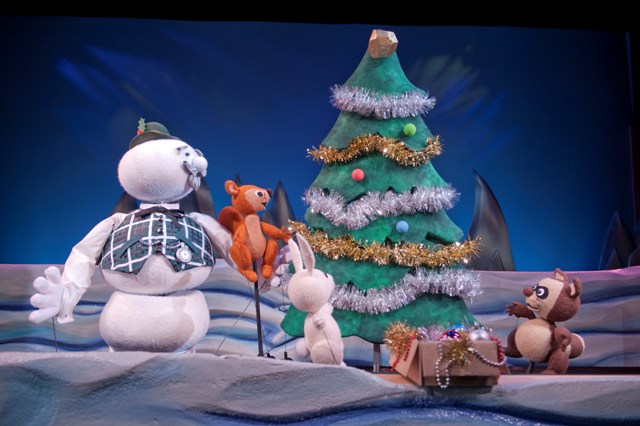
Sam the Snowman supervises the decorating of "Silver and Gold" decorations on dancing Christmas trees with the help of some woodland friends. Photo credit: Clay Walker.
Last year’s production sold out early in its run. How gratifying was that and why do you think this show has such an enduring appeal?
A sold-out run is the best any theater can hope for. The story and characters are still relevant today. It is about coming to grips with yourself and finding your place in the world. This is a theme that never gets old.
I know of plenty of adults who were as excited or more so than the kids to see it last year. Do you have any sense of how adults came to see it on their own out of nostalgia? Will you have any night performances targeted at adults, and are adults welcome to make their own Rudolph puppet, too?
We have seen many couples and groups who come without kids. I think they are re-living their childhood. It makes for a very good date. There are 3 p.m. shows Saturdays and Sundays and a 7 p.m. show on November 25.
What was the biggest challenge you faced in adapting RUDOLPH from TV screen to stage and how did you surmount it?
We had to change the visual language from film to stage. We have used supplemental projected animation to help with transitions. We use a change in scale to get long shots, i.e., we use small versions of the same characters. There are many set changes to get a sense of the journey that is essential to the story. Sometimes we had to add lines and business during entrances and exits. In the film, they just cut away. We found out that the live puppet actors still had to walk off. So we added some lines that are totally in character that allow the puppets to get off stage. We had to combine some scenes to get a better theatrical flow. All of this was a lot of fun and challenging.
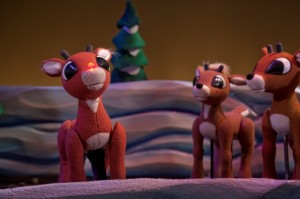
Rudolph's nose is revealed to Fireball & other fawns during Reindeer Games. Photo credit: Clay Walker.
Did you make any changes this year or is it the same production?
The script has not change. Why mess with something that has worked since 1964. There have been improvements with the puppets. What is different about this year is the energy and fun that the performers are bringing to the show. It is the same cast. So they are really focused on the characters and the story. Having gone through the process of getting it on its feet already, they are a championship team. They are having a blast and that is reaching our audiences.
RUDOLPH has so many colorful characters from the misfit toys to the elves to the rabbit and raccoon pairs and that squirrel and that ornery gold nugget. Beyond the misfit heroes Rudolph and Hermey, do you have a personal favorite among the secondary characters and why?
When I was a kid I loved monsters; still do. So I really liked the Bumble Snow Monster of the North. And, in the end he finds his place in the world, too. The monster is accepted.
One thinks of puppetry as a skill in movement, but it also requires a lot of vocal flexibility. Did you consider vocals in casting and did the puppeteers use any special techniques to get their voices so close to the original TV cast?
We held several long sessions with many of our regular and, I must say, gifted puppeteers. We recorded them reading for multiple characters. We even had Allison Murphy, who plays Rudolph, read for the Bumble just for fun. We then spent a lot of time listening to the reading and made our selection. They all did great, but we had to narrow down the field. Those who were chosen then spent many hours listening to the original voices. They still listen to them when they feel they might be drifting from the original voices.
For the most part, you stuck faithfully to the plot, dialogue and songs, but in a few places, you added a few fun—let’s say—embellishments. I hate to give away any surprises, but how did you decide when it was OK to make a change, and how has the audience reacted to that?
We only changed when it was necessary to further the story along for the stage. We threw in some puppet trickery. And the cast understands these characters so well that they were allowed to ad lib if they felt an urge during the rehearsals. This led to some embellishments which deepen the characters rather than just go for a cheap laugh.
Our audiences are very smart. They know that we must make some changes in order to adapt the film for the stage. We keep any changes in character. And any changes were put by Character Arts first.
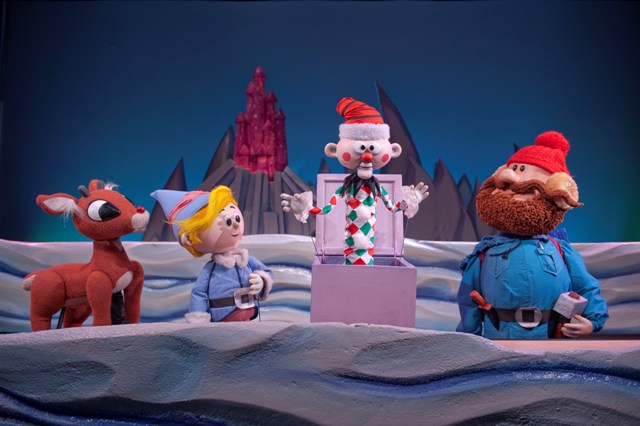
The Misfits from Christmastown land on the Island of Misfit Toys. Photo credit: Clay Walker.
It’s interesting how you handled a couple of spots of political incorrectedness. At the first point where Dasher says searching for Rudolph is “man’s work,” you maintain the comment but beef up the bonding between Mom and Clarice who obviously disagree (and did in the original, too!). Later, after the apparent vanquishing of Bumble, you omit Sam’s statement about how they “had to get the womenfolk back to Christmastown.” Any comments?
Yes, Dasher’s statement about “Man’s work” is very much made fun of in the original by Sam the Snowman. As far as getting the “women folk” back to Christmastown, “the times they are a changing.” It was easier just to omit that line. The mood is very sad at that moment because they thinkYukonhas perished from the fall off the cliff. The “women folk” line would probably have gotten a laugh or been distracting to the moment.
Do you have any interest in adapting any of the other Rankin-Bass stop-motion animated holiday specials such as SANTA CLAUS IS COMING TO TOWN, THE YEAR WITHOUT A SANTA CLAUS or HERE COMES PETER COTTONTAIL?
We have not considered other titles at this time. However, Character Arts has been very open about further collaborations, so we’ll see where that leads.
What question did I not ask that you’d love to answer about RUDOLPH? And what’s the answer?
You have really done your homework! Great questions. There are long debates about why the elf tosses the bird that cannot fly but swims off the sleigh without an umbrella. You can hear the laughs at that moment from those who really know the film. So, if anyone knows the reason for this moment, please let us know.








